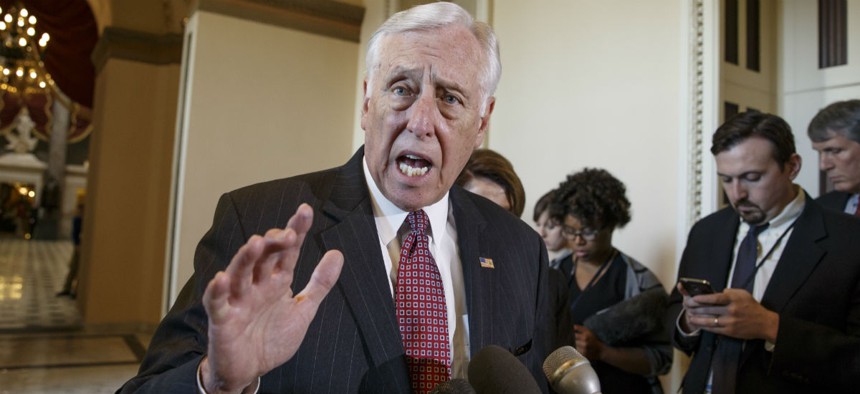White House Sends Bill for $3B IT Fund to Congress

In this photo taken Feb. 27, 2015, House Minority Whip Steny Hoyer, D-Md. speaks on Capitol Hill in Washington. AP Photo/J. Scott Applewhite
Maryland Rep. Steny Hoyer, the House Democratic whip, said he would sponsor the legislation and plans to formally introduce it when Congress returns to session next week.
The White House has formally sent to Congress proposed legislation to establish a $3 billion revolving fund to help federal agencies upgrade aging IT systems.
U.S. Chief Information Officer Tony Scott announced the news Friday in a post on the Office of Management and Budget blog.
Maryland Rep. Steny Hoyer, the House Democratic whip, said he would sponsor the legislation and plans to formally introduce it when Congress returns to session next week.
The legislation has been anticipated since President Barack Obama first proposed an IT modernization fund as part of a series of cybersecurity measures included in his fiscal 2017 budget blueprint.
A review of the federal government’s cybersecurity posture -- initiated in the wake of the massive hack of background investigation records at the Office of Personnel Management -- found the government “relies on legacy systems, software, applications and infrastructure, which are harder to defend against sophisticated actors and less cost effective,” Scott wrote in the blog post.
Of the more than $50 billion civilian agencies spend on IT annually, more than 71 percent -- about $36 billion -- goes toward maintaining so-called legacy systems, leaving little funding for new development. That’s in part due to the dictates of the annual budgeting and appropriations process, critics say.
The proposed IT modernization fund would provide more stable funding, Scott said in the post, which “allows for long-term thinking and shorter development times, rather than costly one-off fixes.”
The legislation calls for an independent panel of experts at the General Services Administration to identify the “highest-priority projects” across government -- archaic systems at high risk of failure or older, more insecure systems that store sensitive data.
Agencies will have to pay back into the fund once their new systems go live. The administration hopes the initial $3.1 billion in “seed funding” can ultimately support at least $12 billion in modernization projects over the next 10 years.
The administration’s proposal so far has garnered a lukewarm reception in Congress.
Last month, Republicans on the House Budget Committee left the proposed IT modernization fund out of the House budget resolution.
The measure has faced skepticism from both Republicans and Democrats on the appropriations committees. The chairman of the House Oversight and Government Reform Committee called the administration’s rationale for the modernization fund “hogwash” during a hearing earlier this year.
In a statement, Hoyer called the bill “a major step” toward transforming the way the government invests in technology.
"This bill will rapidly upgrade our federal IT systems that are most in need of upgrading, either from being cybersecurity risks, inefficient, or costly to maintain,” he said. “It will implement the upgrades using the latest best practices from our innovation economy in Silicon Valley and all across our country."
Separately, a bipartisan Senate bill that has been circulating on Capitol Hill would also establish a revolving for major IT system upgrades. The Cloud IT Act, introduced by Sens. Jerry Moran, R-Kan., and Tom Udall, D-N.M., has not yet been formally introduced.
NEXT STORY: The taxman’s tech troubles





